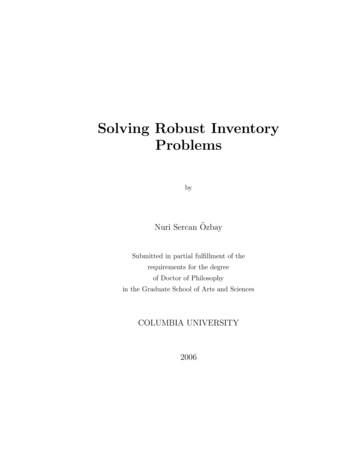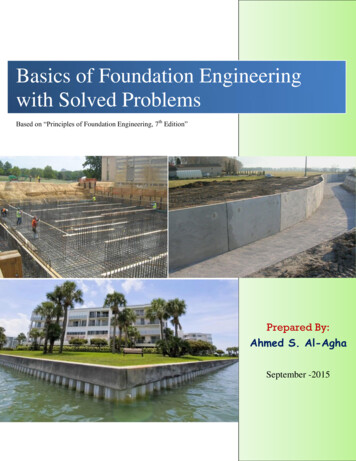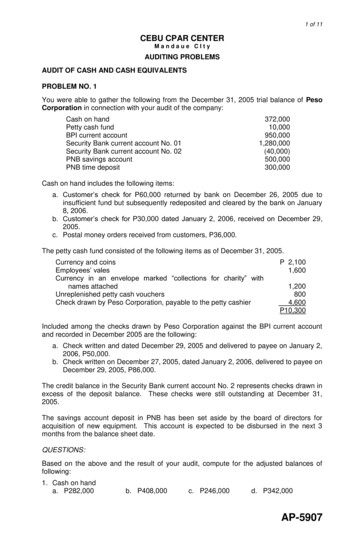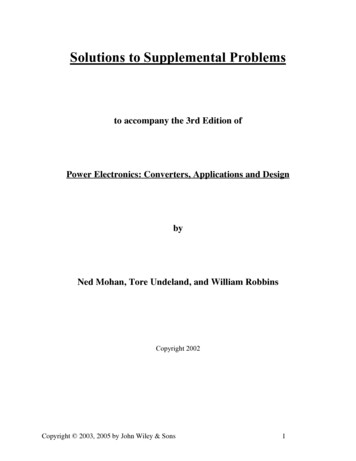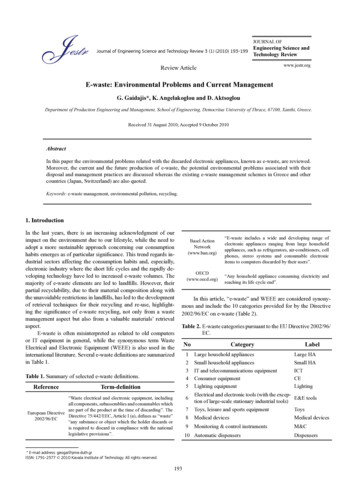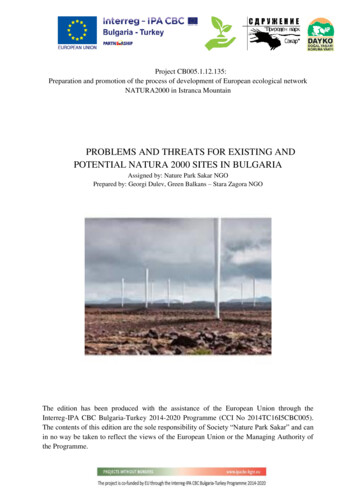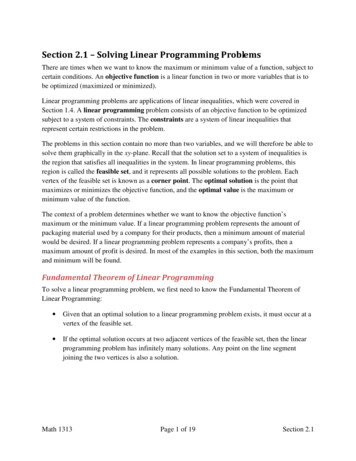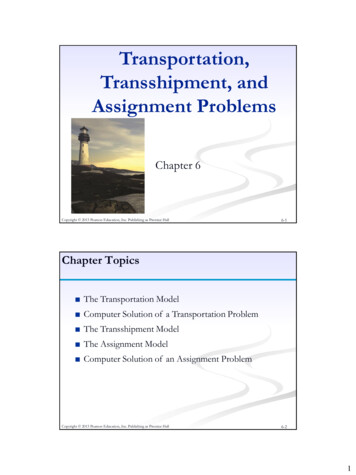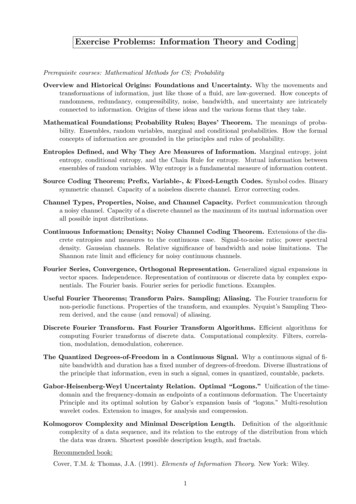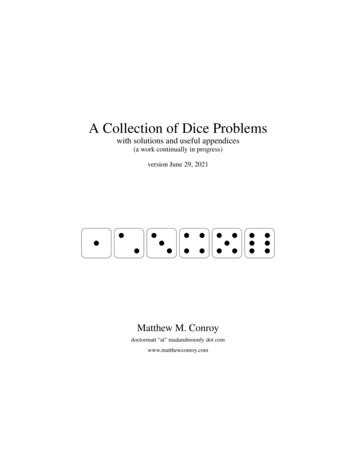
Transcription
A Collection of Dice Problemswith solutions and useful appendices(a work continually in progress)version June 29, 2021Matthew M. Conroydoctormatt “at” madandmoonly dot comwww.matthewconroy.com
A Collection of Dice ProblemsMatthew M. ConroyThanksA number of people have sent corrections, comments and suggestions, including Ryan Allen, Julien Beasley,Rasher Bilbo, Michael Buse, Stephen B, Paul Elvidge, Amit Kumar Goel, Steven Hanes, Nick Hobson, MarcHoltz, Manuel Klein, David Korsnack, Peter Landweber, Jason Cheuk-Man Leung, Paul Micelli, AlbertNatian, João Neto, Khizar Qureshi, Michal Stajszczak, Dave TeBokkel, Eric Vigren, Yichuan Xu and ElieWolfe. Thanks, everyone.2
Chapter 1Introduction and NotesThis is a (slowly) growing collection of dice-related mathematical problems, with accompanying solutions. Some are simple exercises suitable for beginners, while others require more sophisticated techniques.Many dice problems have an advantage over some other problems of probability in that they can beinvestigated experimentally. This gives these types of problems a certain helpful down-to-earth feel.Please feel free to comment, criticize, or contribute additional problems.1.0.1What are dice?In the real world, dice (the plural of die) are polyhedra made of plastic, wood, ivory, or other hardmaterial. Each face of the die is numbered, or marked in some way, so that when the die is cast onto asmooth, flat surface and allowed to come to rest, a particular number is specified.Mathematically, we can consider a die to be a random variable that takes on only finitely many distinctvalues. Usually, these values will constitute a set of positive integers 1, 2, ., n; in such cases, we will referto the die as n-sided.1.0.2TerminologyA fair die is one for which each face appears with equal likelihood. A non-fair die is called fixed. Thephrase standard die will refer to a fair, six-sided die, whose faces are numbered one through six. If nototherwise specified, the term die will refer to a standard die.3
Chapter 2Problems2.1Standard Dice1. On average, how many times must a 6-sided die be rolled until a 6 turns up?2. On average, how many times must a 6-sided die be rolled until a 6 turns up twice in a row?3. On average, how many times must a 6-sided die be rolled until the sequence 65 appears (i.e., a 6followed by a 5)?4. On average, how many times must a 6-sided die be rolled until there are two rolls in a row that differby 1 (such as a 2 followed by a 1 or 3, or a 6 followed by a 5)? What if we roll until there are tworolls in a row that differ by no more than 1 (so we stop at a repeated roll, too)?5. We roll a 6-sided die n times. What is the probability that all faces have appeared?6. We roll a 6-sided die n times. What is the probability that all faces have appeared in order, in somesix consecutive rolls (i.e., what is the probability that the subsequence 123456 appears among the nrolls)?7. We roll a 6-sided die n times. What is the probability that all faces have appeared in some order insome six consecutive rolls?8. Person A rolls n dice and person B rolls m dice. What is the probability that they have a commonface showing (e.g., person A rolled a 2 and person B also rolled a 2, among all their dice)?9. On average, how many times must a 6-sided die be rolled until all sides appear at least once? Whatabout for an n-sided die?10. On average, how many times must a 6-sided die be rolled until all sides appear at least twice?11. On average, how many times must a pair of 6-sided dice be rolled until all sides appear at least once?12. Suppose we roll n dice. What is the expected number of distinct faces that appear?13. Suppose we roll n dice and keep the highest one. What is the distribution of values?14. Suppose we can roll a 6-sided die up to n times. At any point we can stop, and that roll becomes our“score”. Our goal is to get the highest possible score, on average. How should we decide when tostop?4
A Collection of Dice ProblemsMatthew M. Conroy15. How many dice must be rolled to have at least a 95% chance of rolling a six?16. How many dice must be rolled to have at least a 95% chance of rolling a one and a two? What abouta one, a two, and a three? What about a one, a two, a three, a four, a five and a six?17. How many dice should be rolled to maximize the probability of rolling exactly one six? two sixes? nsixes?18. Suppose we roll a fair die 100 times. What is the probability of a run of at least 10 sixes?19. Suppose we roll a fair die until some face has appeared twice. For instance, we might have a run ofrolls 12545 or 636. How many rolls on average would we make? What if we roll until a face hasappeared three times?20. Suppose we roll a fair die 10 times. What is the probability that the sequence of rolls is non-decreasing(i.e., the next roll is never less than the current roll)?21. Suppose a pair of dice are thrown, and then thrown again. What is the probability that the facesappearing on the second throw are the same as the first?What if three dice are used? Or six?22. A single die is rolled until a run of six different faces appears. For example, one might roll the sequence 535463261536435344151612534 with only the last six rolls all distinct. What is the expectednumber of rolls?23. What is the most probable: rolling at least one six with six dice, at least two sixes with twelve dice,or at least three sixes with eighteen dice? (This is an old problem, frequently connected with IsaacNewton.)24. Suppose we roll n dice, remove all the dice that come up 1, and roll the rest again. If we repeat thisprocess, eventually all the dice will be eliminated. How many rolls, on average, will we make? Show,for instance, that on average fewer than O(log n) throws occur.25. Suppose we roll a die 6k times. What is the probability that each possible face comes up an equalnumber of times (i.e., k times)? Find an asymptotic expression for this probability in terms of k.26. Call a “consecutive difference” the absolute value of the difference between two consecutive rollsof a die. For example, the sequence of rolls 14351 has the corresponding sequence of consecutivedifferences 3, 1, 2, 4. What is the expected number of times we need to roll a die until all 6 consecutivedifferences have appeared?2.2Dice Sums27. Show that the probability of rolling 14 is the same whether we throw 3 dice or 5 dice. Are there otherexamples of this phenomenon?28. Show that the probability of rolling a sum of 9 with a pair of 5-sided dice is the same as rolling a sumof 9 with a pair of 10-sided dice. Are there other examples of this phenomenon? Can we prove thereare infinitely many such?5
A Collection of Dice ProblemsMatthew M. Conroy29. Suppose we roll n dice and sum the highest 3. What is the probability that the sum is 18?30. Four fair, 6-sided dice are rolled. The highest three are summed. What is the distribution of the sum?31. Three fair, n-sided dice are rolled. What is the probability that the sum of two of the faces rolledequals the value of the other rolled face?32. A fair, n-sided die is rolled until a roll of k or greater appears. All rolls are summed. What is theexpected value of the sum?33. A pair of dice is rolled repeatedly. What is the expected number of rolls until all eleven possible sumshave appeared? What if three dice are rolled until all sixteen possible sums have appeared?34. A die is rolled repeatedly and summed. What can you say about the expected number of rolls untilthe sum is greater than or equal to n?35. A die is rolled repeatedly and summed. Show that the expected number of rolls until the sum is amultiple of n is n.36. A fair, n-sided die is rolled and summed until the sum is at least n. What is the expected number ofrolls?37. A die is rolled and summed repeatedly. What is the probability that the sum will ever be a given valuex? What is the limit of this probability as x ?38. A die is rolled and summed repeatedly. Let x be a positive integer. What is the probability that thesum will ever be x or x 1? What is the probability that the sum will ever be x, x 1, or x 2? Etc.?39. A die is rolled once; call the result N . Then N dice are rolled once and summed. What is thedistribution of the sum? What is the expected value of the sum? What is the most likely value?What the heck, take it one more step: roll a die; call the result N . Roll N dice once and sum them;call the result M . Roll M dice once and sum. What’s the distribution of the sum, expected value,most likely value?40. A die is rolled once. Call the result N . Then, the die is rolled N times, and those rolls which areequal to or greater than N are summed (other rolls are not summed). What is the distribution of theresulting sum? What is the expected value of the sum?41. Suppose n six-sided dice are rolled and summed. For each six that appears, we sum the six, and rerollthat die and sum, and continue to reroll and sum until we roll something other than a six with that die.What is the expected value of the sum? What is the distribution of the sum?42. A die is rolled until all sums from 1 to x are attainable from some subset of rolled faces. For example,if x 3, then we might roll until a 1 and 2 are rolled, or until three 1s appear, or until two 1s and a 3.What is the expected number of rolls?43. How long, on average, do we need to roll a die and sum the rolls until the sum is a perfect square(1, 4, 9, 16, . . . )?44. How long, on average, do we need to roll a die and sum the rolls until the sum is prime? What if weroll until the sum is composite?45. What is the probability that, if we roll two dice, the product of the faces will start with the digit ’1’?What if we roll three dice, or, ten dice? What is going on?6
A Collection of Dice Problems2.3Matthew M. ConroyNon-Standard Dice46. Show that the probability of rolling doubles with a non-fair (“fixed”) die is greater than with a fair die.47. Is it possible to have a non-fair six-sided die such that the probability of rolling 2, 3, 4, 5, and 6 is thesame whether we roll it once or twice (and sum)? What about for other numbers of sides?48. Find a pair of 6-sided dice, labelled with positive integers differently from the standard dice, so thatthe sum probabilities are the same as for a pair of standard dice.49. Is it possible to have two non-fair n-sided dice, with sides numbered 1 through n, with the propertythat their sum probabilities are the same as for two fair n-sided dice?50. Is it possible to have two non-fair 6-sided dice, with sides numbered 1 through 6, with a uniform sumprobability? What about n-sided dice?51. Suppose that we renumber three fair 6-sided dice (A, B, C) as follows: A {2, 2, 4, 4, 9, 9},B {1, 1, 6, 6, 8, 8}, and C {3, 3, 5, 5, 7, 7}.(a) Find the probability that die A beats die B; die B beats die C; die C beats die A.(b) Discuss.52. Find every six-sided die with sides numbered from the set {1,2,3,4,5,6} such that rolling the dietwice and summing the values yields all values between 2 and 12 (inclusive). For instance, the dienumbered 1,2,4,5,6,6 is one such die. Consider the sum probabilities of these dice. Do any of themgive sum probabilities that are “more uniform” than the sum probabilities for a standard die? Whatif we renumber two dice differently - can we get a uniform (or more uniform than standard) sumprobability?15553. If we roll a standard die twice and sum, the probability that the sum is prime is 36 12. If werenumber the faces of the die, what is the largest probability of a prime sum that can be achieved?54. Let’s make pairs of dice that only sum to prime values. If we minimize the sum of all the values onthe faces, what dice do we get for 2-sided dice, 3-sided dice, etc.?55. Show that you cannot have a pair of dice with more than two sides that only gives sums that areFibonacci numbers.2.4Games with Dice56. Two players each roll two dice, first player A, then player B. If player A rolls a sum of 6, they win. Ifplayer B rolls a sum of 7, they win. They take turns, back and forth, until someone wins. What is theprobability that player A wins?57. In the previous problem, we find out that the game is not fair. Are there sum targets for player A andplayer B that would make the game fair? What about using a different number of dice, or allowingtargets to include more than one sum?7
A Collection of Dice ProblemsMatthew M. Conroy58. Two players each roll two dice. Player A is trying to roll a sum of 6, player B is trying to roll asum of 7. Player A starts, and rolls once. Then Player B rolls twice, then Player A rolls twice, andthey repeat, both players rolling twice in succession until someone rolls their target sum. What is theprobability of winning for each player?59. Two players each roll a die. Player 1 rolls a fair m-sided die, while player 2 rolls a fair n sided die,with m n. The winner is the one with the higher roll. What is the probability that Player 1 wins?What is the probability of a tie? If the players continue rolling in the case of a tie until they do not tie,which player has the higher probability of winning? If the tie means a win for Player 1 (or player 2),what is their probability of winning?60. Two players each start with 12 tokens. They roll three dice until the sum is either 11 or 14. If the sumis 14, player A gives a token to player B; if the sum is 11, player B gives a token to player A. Theyrepeat this process until one player, the winner, has all the tokens. What is the probability that playerA wins?61. Two players each start a game with a score of zero, and they alternate rolling dice once to add to theirscores. Player A rolls three six-sided dice on each turn, while player B always gets 11 points on theirturn. If the starting player is chosen by the toss of a coin, what is the probability that player A will bethe first to 100 points?62. Craps The game of craps is perhaps the most famous of all dice games. The player begin bythrowing two standard dice. If the sum of these dice is 7 or 11, the player wins. If the sum is 2,3 or12, the player loses. Otherwise, the sum becomes the player’s point. The player continues to roll untileither the point comes up again, in which case the player wins, or the player throws 7, in which casethey lose. The natural question is: what is a player’s probability of winning?63. Non-Standard Craps We can generalize the games of craps to allow dice with other than sixsides. Suppose we use two (fair) n-sided dice. Then we can define a game analogous to craps in thefollowing way. The player rolls two n-sided dice. If the sum of these dice is n 1 or 2n 1, theplayer wins. If the sum of these dice is 2, 3 or 2n, then the player loses. Otherwise the sum becomesthe player’s point, and they win if they roll that sum again before rolling n 1. We may again ask:what is the player’s probability of winning?64. Yahtzee There are many probability questions we may ask with regard to the game of Yahtzee. Forstarters, what is the probability of rolling, in a single roll,(a) Yahtzee(b) Four of a kind (but not Yahtzee)(c) Three of a kind (but not four of a kind or Yahtzee)(d) A full house(e) A long straight(f) A small straight65. More Yahtzee What is the probability of getting Yahtzee, assuming that we are trying just to getYahtzee, we make reasonable choices about which dice to re-roll, and we have three rolls? That is,assume we’re in the situation where all we have left to get in a game of Yahtzee is Yahtzee, so that allother outcomes are irrelevant.8
A Collection of Dice ProblemsMatthew M. Conroy66. Drop Dead In the game of Drop Dead, the player starts by rolling five standard dice. If there areno 2’s or 5’s among the five dice, then the dice are summed and this is the player’s score. If there are2’s or 5’s, these dice become “dead” and the player gets no score. In either case, the player continuesby rolling all non-dead dice, adding points onto the score, until all dice are dead.For example, the player might roll {1, 3, 3, 4, 6} and score 17. Then they roll all the dice again and get{1, 1, 2, 3, 5} which results in no points and two of the dice dying. Rolling the three remaining dice,they might get {2, 3, 6} for again no score, and one more dead die. Rolling the remaining two theymight get {4, 6} which gives them 10 points, bringing the score to 27. They roll the two dice again,and get {2, 3} which gives no points and another dead die. Rolling the remaining die, they might get{3} which brings the score to 30. Rolling again, they get {5} which brings this player’s round to anend with 30 points.Some natural questions to ask are:(a) What is the expected value of a player’s score?(b) What is the probability of getting a score of 0? 1? 20? etc.67. Threes In the game of Threes, the player starts by rolling five standard dice. In the game, the threescount as zero, while the other faces count normally. The goal is to get as low a sum as possible. Oneach roll, at least one die must be kept, and any dice that are kept are added to the player’s sum. Thegame lasts at most five rolls, and the score can be anywhere from 0 to 30.For example a game might go like this. On the first roll the player rolls2 3 3 4 6The player decides to keep the 3s, and so has a score of zero. The other three dice are rolled, and theresult is1 5 5Here the player keeps the 1, so their score is 1, and re-rolls the other two dice. The result is1 2Here, the player decides to keep both dice, and their final score is 4.If a player plays optimally (i.e., using a strategy which minimizes the expected value of their score),what is the expected value of their score?68. Suppose we play a game with a die where we roll and sum our rolls. We can stop any time and takethe sum as our score, but if we roll a face we’ve rolled before then we lose everything. What strategywill maximize our expected score?69. (Same as previous game, but with two dice.) Suppose we play a game with two dice where we rolland sum our rolls. We can stop any time and take the sum as our score, but if we roll a sum we’verolled before then we lose everything. What strategy will maximize our expected score?70. Suppose we play a game with a die where we roll and sum our rolls. We can stop any time and takethe sum as our score, but if we roll the same face twice in a row we lose everything. What strategywill maximize our expected score?71. Suppose we play a game with a die where we roll and sum our rolls as long as we keep rolling largervalues. For instance, we might roll a sequence like 1-3-4 and then roll a 2, so our sum would be 8. Ifwe roll a 6 first, then we’re through and our sum is 6. Three questions about this game:9
A Collection of Dice ProblemsMatthew M. Conroy(a) What is the expected value of the sum?(b) What is the expected value of the number of rolls?(c) If the game is played with an n-sided die, what happens to the expected number of rolls as napproaches infinity?72. Suppose we play a game with a die where we roll and add our rolls to our total when the face thatappears has not occurred before, and subtract it from our total if it has.For example, if we rolled the sequence 1, 3, 4, 3, our corresponding totals would be 1, 4, 8, 5.We can stop any time and take the total as our score. What strategy should we employ to maximizeour expected score?73. Suppose we roll a single die, repeatedly if we like, and sum. We can stop at any point, and the sumbecomes our score; however, if we exceed 10, our score is zero.What should our strategy be to maximize the expected value of our score? What is the expected scorewith this optimal strategy?What about limits besides 10?74. Suppose we play a game with a die where we roll and sum our rolls. We can stop any time, and thesum is our score. However, if our sum is ever a multiple of 10, our score is zero, and our game is over.What strategy will yield the greatest expected score? What about the same game played with valuesother than 10?75. Suppose we play a game with a die in which we use two rolls of the die to create a two-digit number.The player rolls the die once and decides which of the two digits they want that roll to represent. Then,the player rolls a second time and this determines the other digit. For instance, the player might roll a5, and decide this should be the “tens” digit, and then roll a 6, so their resulting number is 56.What strategy should be used to create the largest number on average? What about the three digitversion of the game?10
Chapter 3Discussion, Hints, and Solutions3.1Single Die Problems1. On average, how many times must a 6-sided die be rolled until a 6 turns up?This problem is asking for the expected number of rolls until a 6 appears. Let X be the randomvariable representing the number of rolls until a 6 appears. Then the probability that X 1 is 1/6;the probability that X 2 is (5/6)(1/6) 5/36. In general, the probability that X k is k 11566(3.1)since, in order for X to be k, there must be k 1 rolls which can be any of the numbers 1 through 5,and then a 6, which appears with probability 1/6.We seek the expectation of X. This is defined to beE XnP (X n)(3.2)n 1where P (X n) is the probability that X takes on the value n. Thus, n 1 n X516 1X5 ·E nn665 66n 1(3.3)n 1Using Equation B.3 from Appendix B, we can conclude thatE 6 15/6· 6.5 6 (1 (5/6))2(3.4)Thus, on average, it takes 6 throws of a die before a 6 appears.Here’s another, quite different way to solve this problem. When rolling a die, there is a 1/6 chance thata 6 will appear. If a 6 doesn’t appear, then we’re in essence starting over. That is to say, the number oftimes we expect to throw the die before a 6 shows up is the same as the number of additional times weexpect to throw the die after throwing a non-6. So we have a 1/6 chance of rolling a 6 (and stopping),11
A Collection of Dice ProblemsMatthew M. Conroyand a 5/6 chance of not rolling a six, after which the number of rolls we expect to throw is the sameas when we started. We can formulate this asE 1 5 (E 1) .6 6(3.5)Solving for E, we find E 6. Note that Equation 3.5 implicitly assumes that E is a finite number,which is something that, a priori, we do not necessarily know.2. On average, how many times must a 6-sided die be rolled until a 6 turns up twice in a row?We can solve this using a recurrence relation on, E, the expected number of rolls. When we startrolling, we expect, on average 6 rolls until a 6 shows up. Once that happens, there is a 1/6 chance thatwe will roll once more, and a 5/6 chance that we will be, effectively, starting all over again, and sohave as many additional expected rolls as when we started. As a result, we can sayE 6 15· 1 (E 1).66Solving this, we find that E 42.3. On average, how many times must a 6-sided die be rolled until the sequence 65 appears (i.e., a 6followed by a 5)?This appears to be quite similar to problem 2, but there is a difference. In problem 2, once we roll a6, there are only two possibilities: either we roll a 6, or we start all over again.In this problem, once we roll a 6, there are three possibilities: (a) we roll a 5, (b), we roll a 6, or (c)we start all over again.We can again solve it using recursion, but we’ll need two equations. Let E be the expected number ofrolls until 65 and let E6 be the expected number of rolls until 65 when we start with a rolled 6. Then:1E6 (E6 1) 61E (E6 1) 641(E 1) (1)665(E 1)6This gives us a system of two linear equations in two unknowns, which we can solve to findE 36, E6 30.So it takes fewer rolls on average to see a 6 followed by a 5 than it does to see a 6 followed by a 6.4. On average, how many times must a 6-sided die be rolled until there are two rolls in a row that differby 1 (such as a 2 followed by a 1 or 3, or a 6 followed by a 5)? What if we roll until there are tworolls in a row that differ by no more than 1 (so we stop at a repeated roll, too)?Let E be the expected number of rolls. Let Ei be the expected number of rolls after rolling an i (notfollowing a roll of i 1 or i 1).Then we have1E 1 (E1 E2 E3 E4 E5 E6 ).6By symmetry, we know that E1 E6 , E2 E5 and E3 E4 , so2E 1 (E1 E2 E3 ).612
A Collection of Dice ProblemsWe can express E1 asMatthew M. Conroy212E1 1 E1 E2 E3666since there will definitely be an additional roll, there is a 61 chance that this will be the last roll (i.e.,we roll a 2) and the five other possibilities are equally likely.Similarly,211E2 1 E1 E2 E3666and211E3 1 E1 E2 E3 .666This gives us a system of three linear equations in three unknowns.Solving, we findE1 and soE 705860, E2 , and E3 171717239 4.68627450980.51If we stop when we have a repeated roll, too, the situation is similar. Defining E, E1 , E2 , and E3 asabove, we have the system2E 1 (E1 E2 E3 )6112E1 1 E1 E2 E3666111E2 1 E1 E2 E366621E3 1 E1 E2 .66Solving this, we findE1 288246252, E2 , and E3 .115115115and soE 377 3.278260869565.1155. We roll a 6-sided die n times. What is the probability that all faces have appeared?Let P (n) stand for the probability that all faces have appeared in n rolls.To determine P (n), we can use the principle of inclusion-exclusion.We wish to count the number of roll sequences that do not contain all faces.There are 6n ways to roll a die n times.Of these, 5n have no 1, 5n have no 2, etc.Simply adding those will not yield what we seek, since there are roll sequences that contain no 1 andno 2 (for example), so we would be counting those twice.As a result, we take that sum and subtract all the roll sequences with both no 1 and no 2, or both no 1and no 3, etc.13
A Collection of Dice ProblemsMatthew M. ConroyAgain, we will not have quite what we wish, since we will have removed sequences that contain, say,both no 1 and no 2, and no 1 and no 3, twice.Hence, we have to add back in the number of sequences that fail to have three faces.We continue in this way, alternating subtracting and adding numbers of sequences, until we reach thefinal count: no sequence can fail to have all 6 faces.All together, then, we find that the number of sequences that fail to have all 6 faces is 6 n6 n6 n6 n6 n5 4 3 2 1 .12345Hence, the probability of having all 6 faces appear in n rolls of the die is n n n n n6564636261 1 6666623451 n n n n n52111 1 6 15 20 15 6632366n 6 · 5n 15 · 4n 20 · 3n 15 · 2n 6. 6nHere is a short table of values of this probability.n123456789101112131415161718192036P (n) P (n) 818923080.847987540.991541886. We roll a 6-sided die n times. What is the probability that all faces have appeared in order, in somesix consecutive rolls (i.e., what is the probability that the subsequence 123456 appears among the nrolls)?This is a rather tedious calculation, but a nice way to handle it is as a Markov chain. We define a zerostate (the state we start in, and the state we are in if the current rolls value was not preceded by thesmaller values in order (e.g., if the current roll is a 2, but the previous roll was not a 1), and then sixstates corresponding to having a current “streak” of 1, 12, 123, 1234, 12345, 123456. Call these states14
A Collection of Dice ProblemsMatthew M. Conroyone through six. The last state is an absorbing state. We then have the following transition matrix: 561600000 2 3 2 3 M 23 2 3 2 30161600016016001600160160001616000000000 0 0 0 0 1 6 1Then, the probability p we seek is the last entry in the first row of M n . Using a computer algebrasystem, these probabilities can be calculated exactly. Here is a short table of values, calculated exactlyand then converted to decimal 00008000090000100000200000300000p, 6648It may be useful to note that, for n 1000, say, 1 np 1 1 66is a quite good approximation.7. We roll a 6-sided die n times. What is the probability that all faces have appeared in some order insome six consecutive rolls?The use of a Markov chain is helpful here.As we roll the die, let the state of the chain be the length of the current run of different faces that haveappeared. For example, if we’ve rolled 1232535 we would be in state 2 and if we’ve rolled 62134215
A Collection of Dice ProblemsMatthew M. Conroywe would be in state 4. Then we can treat the game as starting in state 0 and ending in state 6, thelone absorbing state, and our transition matrix,A, is: 0 1 0 0 0 0 0 0 1 5 0 0 0 0 66 1210000 663 1111 A 0 6 6 6 2 0 0 0 16 61 61 16 31 0 0 1 1 1 1 1 1 666666 0 0 0 0 0 0 1The last entry in the first row of Ak is the probability that we have had a run of six distinct faces in sixconsecutive rolls after rolling n times.Here’s a short 002393103644185445/324 0.015432098765432155/1944 0.0282921810699588475/11664 0.04072359396433471235/23328 0.052
A fair die is one for which each face appears with equal likelihood. A non-fair die is called fixed. The phrase standard die will refer to a fair, six-sided die, whose faces are numbered one through six. If not otherwise specified, the term die


